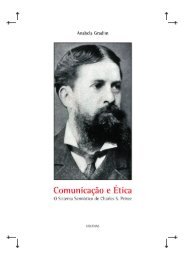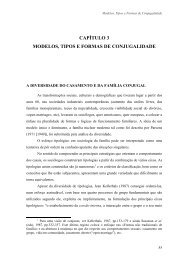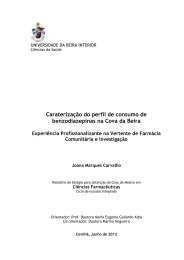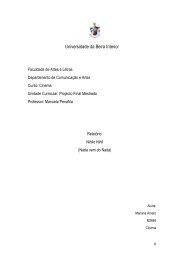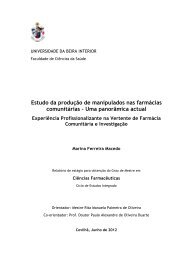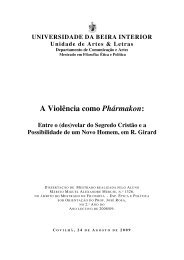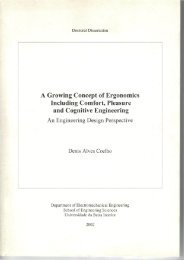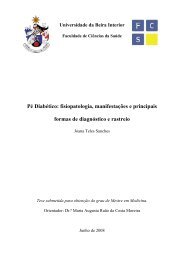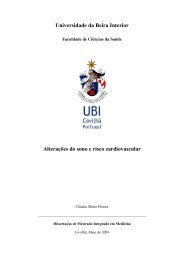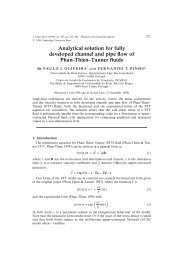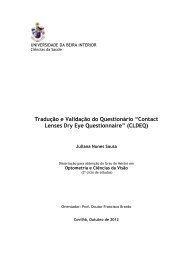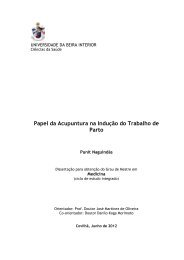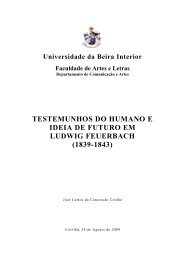Tese_Tânia Vieira.pdf - Ubi Thesis
Tese_Tânia Vieira.pdf - Ubi Thesis
Tese_Tânia Vieira.pdf - Ubi Thesis
You also want an ePaper? Increase the reach of your titles
YUMPU automatically turns print PDFs into web optimized ePapers that Google loves.
Chapter II – Materials and Methods<br />
2.2.8. Proliferation of cells in the presence of the produced<br />
nanoparticles<br />
Human osteoblast cells were cultured with Dulbecco’s modified Eagle’s medium (DMEM-<br />
F12) supplemented with heat-inactivated FBS (10% v/v), penicillin G (100 units/mL),<br />
streptomycin (100 μg/mL) and amphotericin B (0.25 μg/mL). Cells were seeded in 75 cm 3 T-flasks<br />
until confluence was obtained. Detachment of confluent cells was achieved by a 3 min<br />
incubation in 0.18% trypsin (1:250) and 5 mM EDTA. Then, an equal volume of culture medium<br />
was added to the free cells in order to stop the reaction. The cells were centrifuged, the pellet<br />
was resuspended in culture medium, and the cells were then seeded in new 75 cm 3 T-flasks<br />
(Ribeiro et al. 2009). To verify the influence of the presence of the produced nanoparticles in<br />
cell adhesion and proliferation, cells were seeded with nanoparticles in a 96-well plate at a<br />
density of 15×10 3 cells/well, for 24 and 48 h. Before this procedure, plates and the materials<br />
were UV sterilized for 30 min. Cell growth was monitored using an Olympus CX14 inverted light<br />
microscope (Tokyo, Japan) equipped with an Olympus SP-500 UZ digital camera.<br />
2.2.9. Evaluation of the cytotoxic profile of the produced nanoparticles<br />
The MTS assay was performed in order to evaluate nanoparticles toxicity. Human<br />
osteoblast cells, at a density of 15×10 3 per well, were seeded in a 96-well plate and cultured<br />
with DMEM-F12. At the same time, in another 96-well culture plate, DMEM-F12 was added to the<br />
produced nanoparticles that were previously irradiated with UV light for 30 min, in order to be<br />
sterilized. The nanoparticles were left in contact with medium for 24 and 48 h. After the period<br />
of incubation, the cell culture medium was removed and replaced with 100 µL of medium that<br />
was in contact with the nanoparticles. Then, cells were incubated at 37°C, in a 5% CO 2<br />
humidified atmosphere for more 24 h. The cell viability and proliferation was assessed through<br />
the reduction of MTS into a water-soluble brown formazan product. Briefly, the medium of each<br />
well was removed and replaced with a mixture of 100 µL of fresh culture medium and 20 µL of<br />
MTS/PMS reagent solution. Then, cells were incubated for 4 h at 37 °C, in a 5% CO 2 atmosphere<br />
(Ribeiro et al. 2009). The absorbance was measured at 490 nm using a Biorad Microplate Reader<br />
Brenchmark (Tokyo, Japan). Wells containing cells in the culture medium without biomaterials<br />
were used as negative control (K - ). EtOH 96% was added to wells containing only cells and was<br />
used as positive control (K + ).<br />
24



